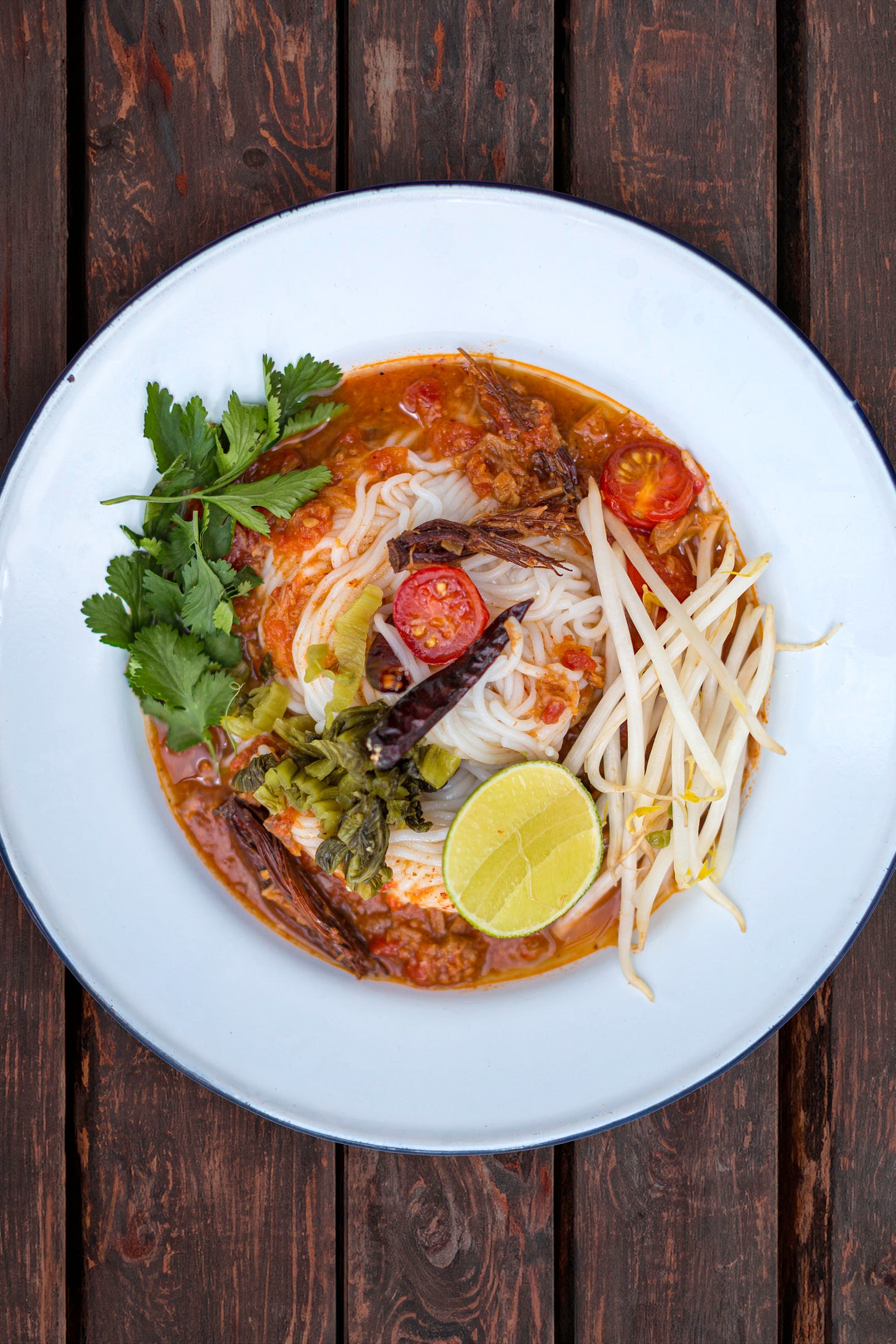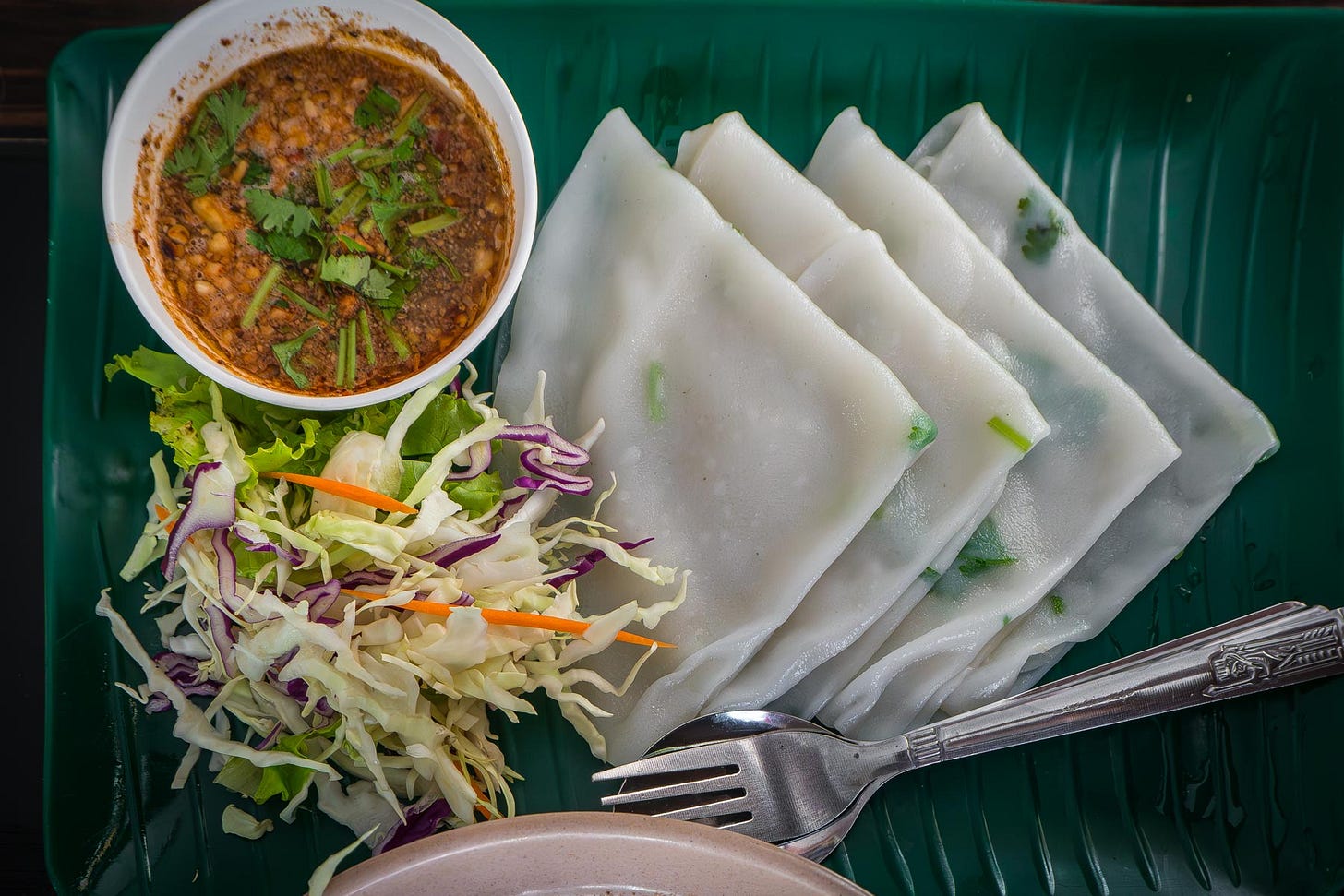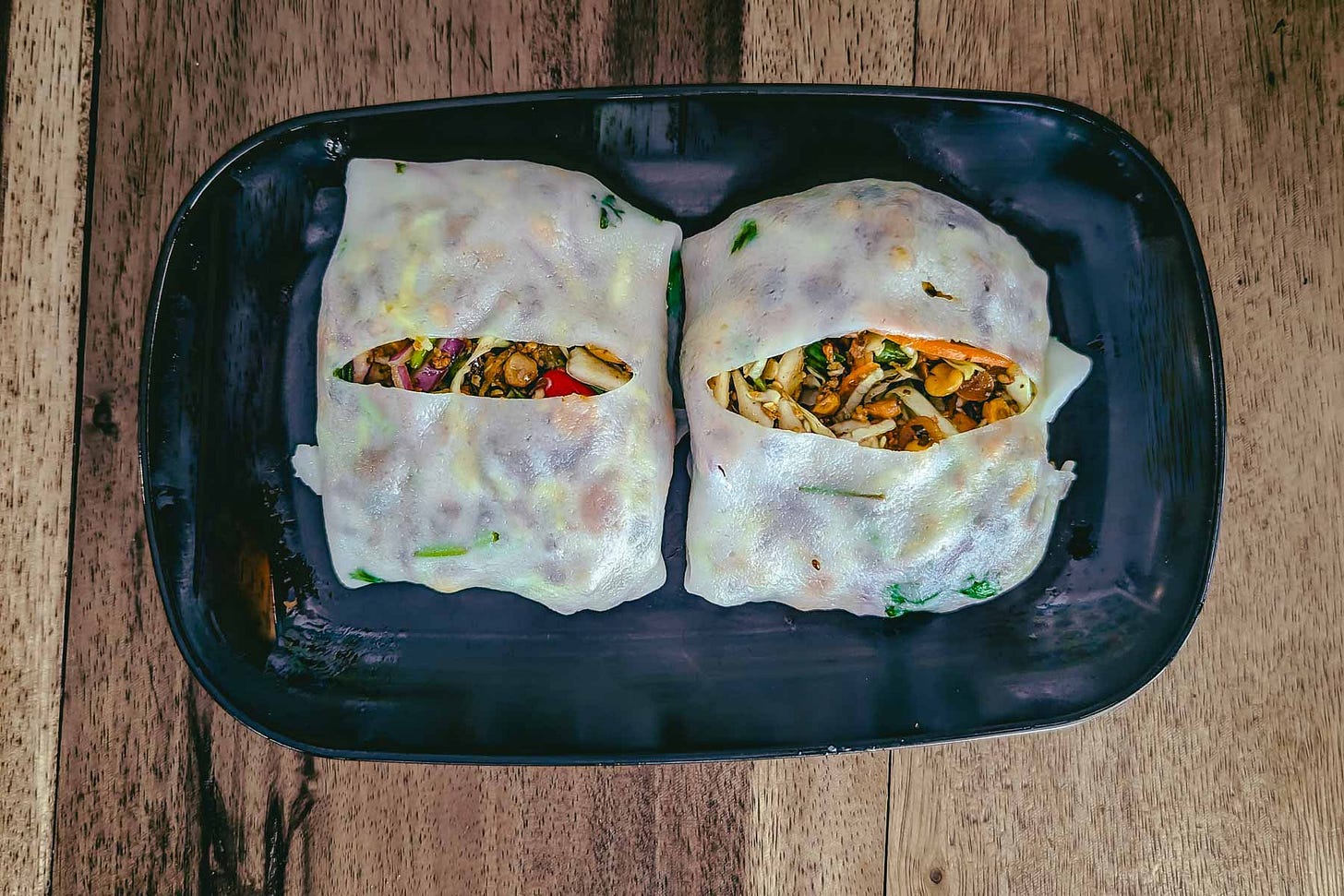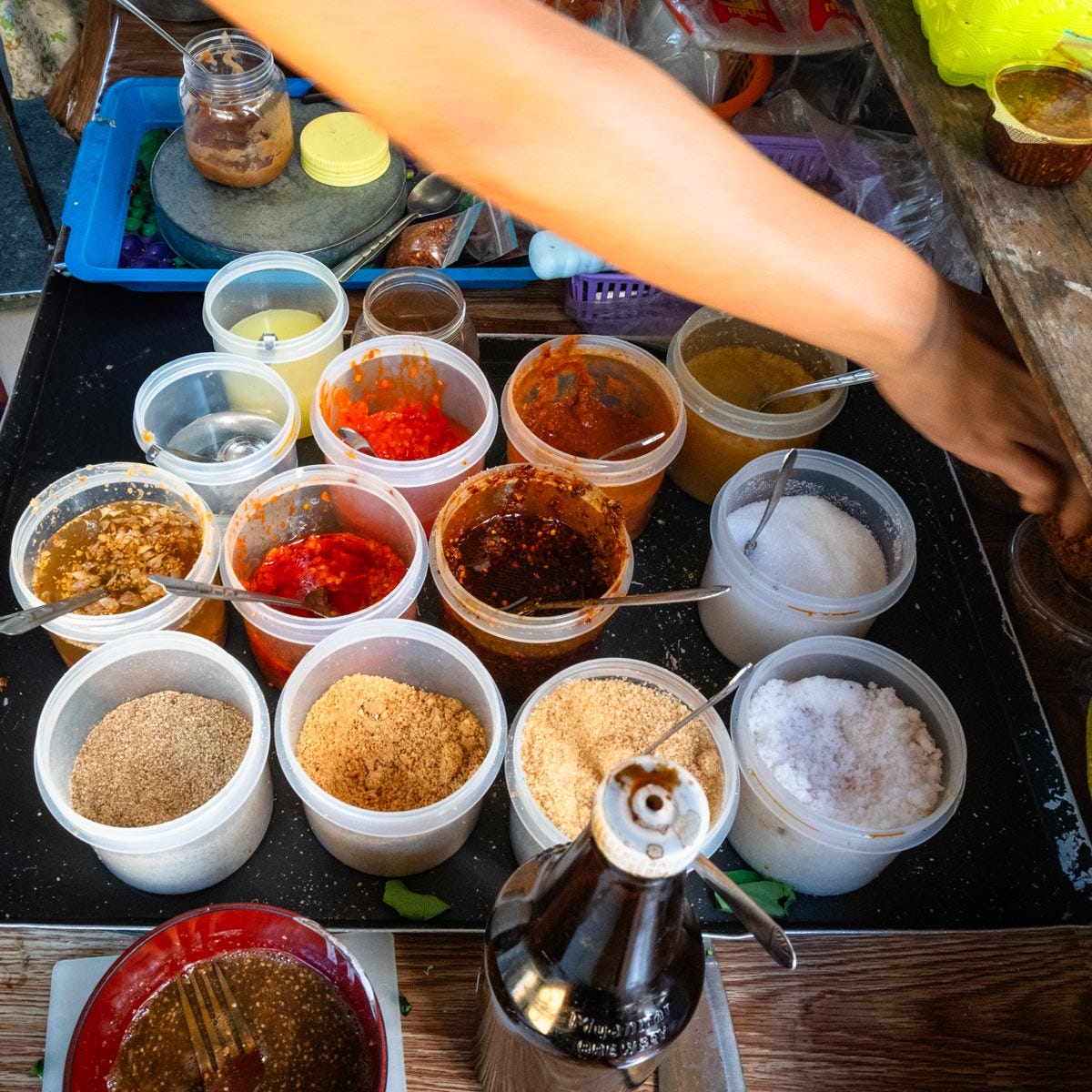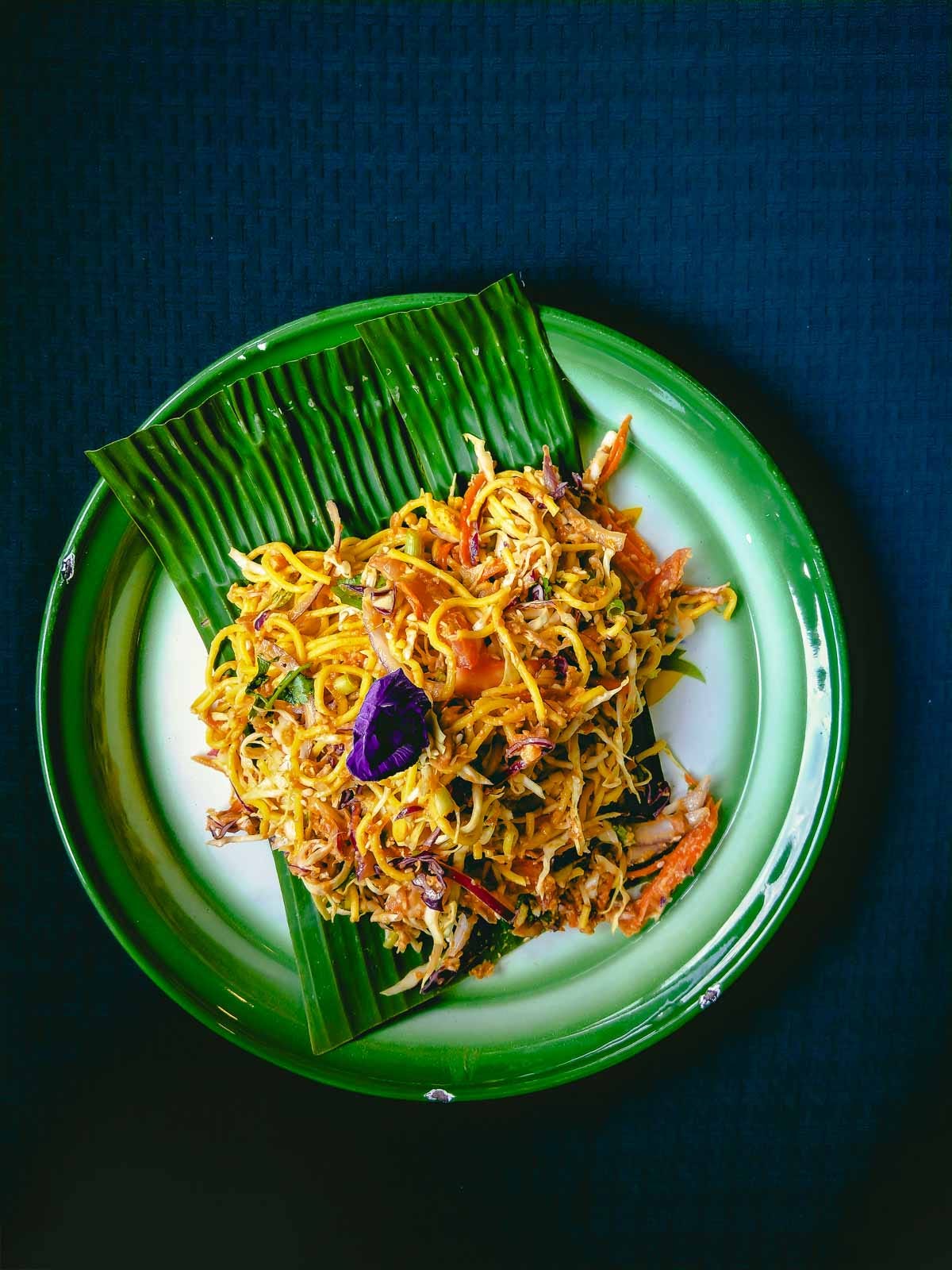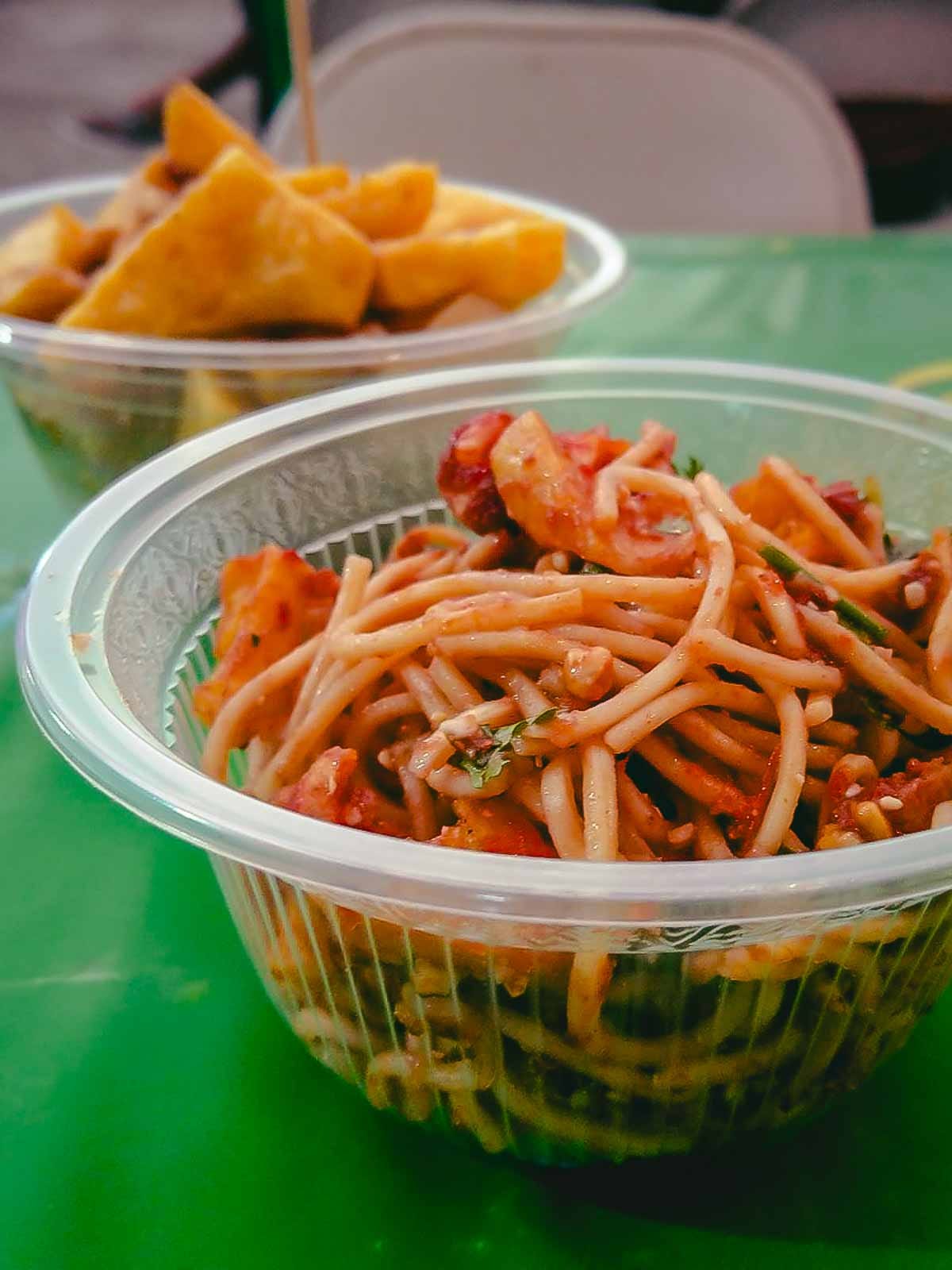Mention khao soi and most will imagine a fragrant coconut curry soup, hearty with wheat noodles, topped with shallots, pickled mustard greens, lime, and a crispy fried noodle garnish. But I want to talk about the diverse variations of khao soi I’ve encountered in Thailand, from clear broths enriched with rich, oily ragù-like seasonings to glistening rice noodle pancakes flavored with chili and fermented soybean pastes.
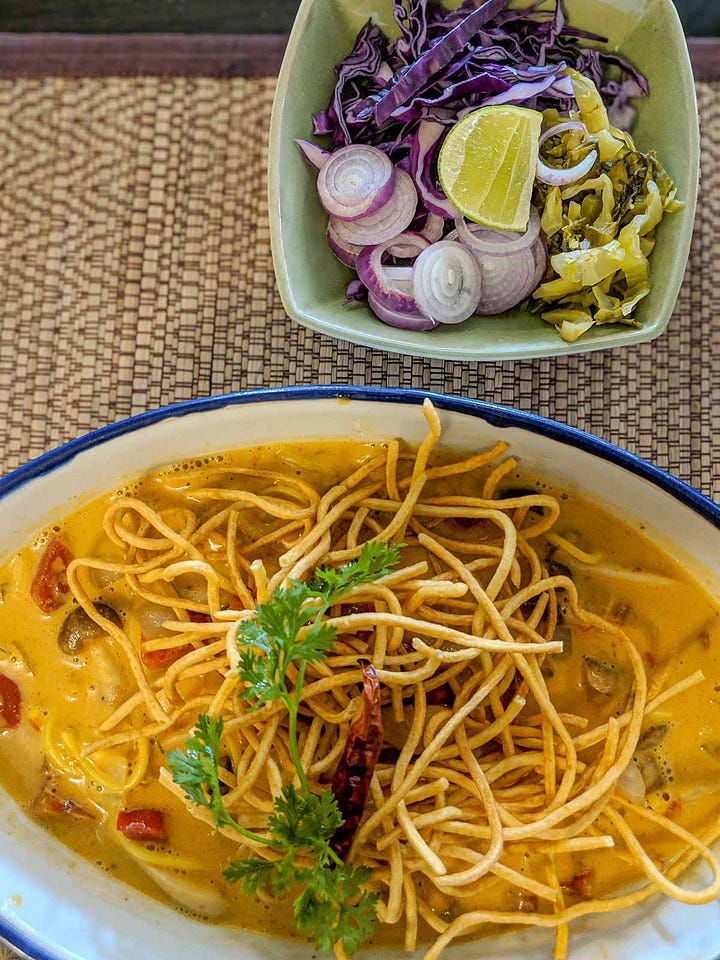
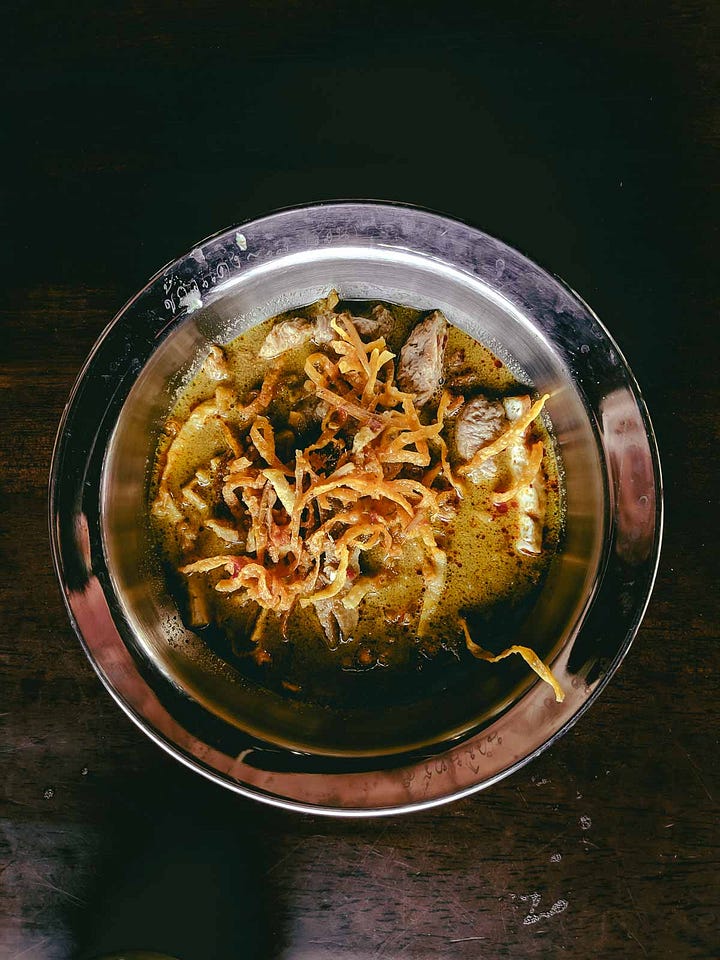
Before we go further though, let’s lay down a few definitions, clarify some terms. When I refer to the khao soi we “know,” I mean the one commonly referred to as Chiang Mai curry noodles. When made well, it’s a smoky, aromatic noodle soup, rich with coconut milk, balanced with sourness from lime and pickled mustard greens. The noodles, typically made with egg but easily made vegan, are dually prepared; boiled noodles are a part of the soup, while a portion of the noodles are fried until crispy as a crown on top of the finished dish. Other components include fresh, raw shallots (or red onions, which I’m seeing more and more of in Thailand) and ground chillies fried in oil.
An inconclusive history of khao soi
The original khao soi, at least the predecessor to the one with which we have familiarity, and there are many more (which I’ll get to in a bit), didn’t contain coconut milk. While all accounts of the provenance of khao soi are speculative, the Jeen Haw (จีนฮ่อ), Yunnan Chinese Muslims who traded widely in the region (including Northern Thailand and Myanmar), are credited with the arrival of the early version of this dish in Thailand.
There's a camp who traces the roots of the dish to ohn-no khao swè, or Burmese coconut noodles. Khao swè, which refers to any sort of noodles in the Burmese language, is argued by some to be the precursor to the word "khao soi" as they sound very similar. Others argue a more direct route from Yunnan, given the earliest documented khao soi in Chiang Mai shares few similarities with the now famous Chiang Mai curry noodles. And there are, of course, many explanations in between.
The origin stories regarding this dish may be unsubstantiated, but of all the narratives I most appreciate the more phenomenological approach Austin Bush writes of in his culinary volume The Food of Northern Thailand.
Broadly, phenomenology is a first-person-centric qualitative method with a focus on lived experience over cause and effect. Bush spoke with multiple khao soi vendors, gathering origin stories and perspectives, and concluded the dish is no more or less than an indication of the commingling of cultures that came to influence the culinary identity of Chiang Mai.
Whether or not there's concrete documentation or an undeniable factual basis for a particular narrative as irrefutable truth, I believe it's reasonable to accept the experience(s) of personal group members as an analytical tool so long as we don't confuse experience with a causal nexus. As a practice, this keeps the door open for others to share their own histories and perspectives within the narrative. After all, something as multifaceted as culture, and always remember that food is culture, is often degraded when we obsess over defining everything too rigidly.
A non extensive list of other types of khao soi
None of the varieties of khao soi I describe below will seem familiar, both in look and flavour, if your only reference is the aforementioned coconut curry noodles. And, as the heading indicates, this isn’t an exhaustive list by any means. I’m just trying to convey variety rather than provide an encyclopaedic reference.
Khao soi nam sai ข้าวซอยน้ำใส / khao soi Yunnan ข้าวซอยยูนนาน
Nam sai translates to "clear broth," meaning this version lacks the coconut milk that defines the modern, near world famous style of khao soi curry noodles. Similar to its coconut curry offspring, khao soi nam sai is also accompanied by condiments such as sliced shallots, lime, and pickled mustard greens—though these pickles are prepared in the Yunnan, rather than Thai, style. Seasoned mince rather than larger pieces of protein likely topped the original khao soi Yunnan, but there is variation in this today.
Apologies for not having a photo. I’ve never had a vegan version of this dish in the wild and my Adobe Lightroom catalogue is a lawless land of haphazard labelling. In other words, I can’t find a picture of the one I made.
Khao soi nam kua ข้าวซอยน้ำคั่ว / khao soi nam naa ข้าวซอยน้ำหน้า (Tai-Lue style rice noodles)
This is another clear stock khao soi, sans coconut milk, served with rice noodles and a Thaified sort of ragù made by simmering soaked dried chillies, garlic, shallots, fermented soybeans and pork over a long period to create a rich tare seasoning called nam naa or nam kua. If you've ever tried nam prik ong, a popular Northern Thai tomato chilli relish, then you already have some familiarity with the flavour profile. The nam naa ingredients vary by vendor, but some sort of protein, fermented soybean (sometimes dried, often fresh), and garlic are pretty standard. Many also add tomatoes and/or turmeric.
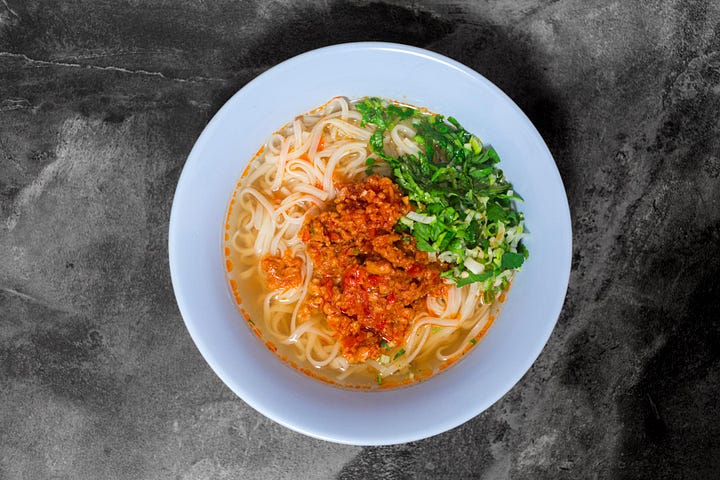
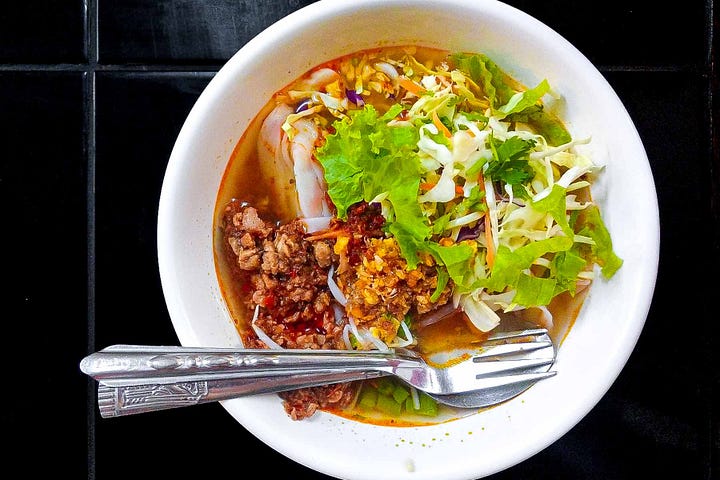
At a minimum the final bowls include rice noodles blanched with bean sprouts, a clear broth, and a generous dollop of the nam naa sauce. Additionally you’re likely to find coriander and spring onion, fried garlic oil, and a green vegetable like chopped long beans. The flavour profile is salty and umami first, with some funky notes from the fermented soy. If tomatoes are included in the sauce, there’s a hint of sourness.
Khao soi nam ngeaw ข้าวซอยน้ำเงี้ยว
Depending on your location, you’ll also frequently hear these brothy curry noodles called kanom jeen nam ngeaw (kanom jeen is a Thai word for the thin extruded rice noodles used in this dish). The word ngeaw is both an ethnic slur for Shan people and the name of an essential ingredient to this dish. Dok ngeow is the dried flower of the red cotton tree, added to the tomato and meat soup for its chewy texture.
Standard toppings include pickled mustard greens, lime, fried garlic in oil, beans sprouts, fried dried chillies, and spring onions.
Khao soi noi jim ข้าวซอยน้อยจิ้ม and yum khao soi noi ยำข้าวซอยน้อย
More comparable to Vietnamese bánh cuốn (in Thai: pak mor yuan ปากหม้อญวน) or bánh ướt than to any bowl of noodles, khao soi noi comes in two varieties. The first is a very thin rice flour pancake, made the same way you’d steam fresh rice noodle sheets, often with some chopped coriander and spring onion in the batter. Once steamed, purveyors peel the sheets from their round trays, quickly folding them – in half, and then once or twice more into a final wedge shape.
This style of khao soi noi is served either as is, with a dipping sauce and shredded veg alongside, or tossed with the sauce and veg as a salad. The former is khao soi noi jim, where jim refers to a dipping sauce. The latter is yum khao soi noi, where yum refers to one of many Thai words for dishes created by mixing some ingredient(s) together with a dressing.
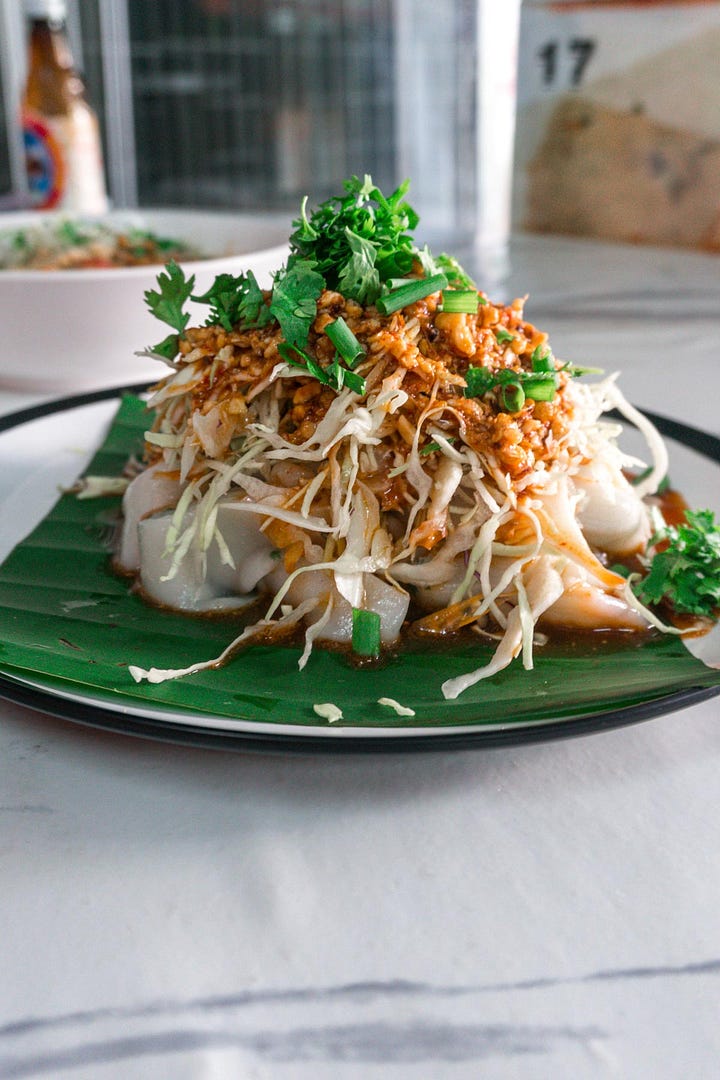
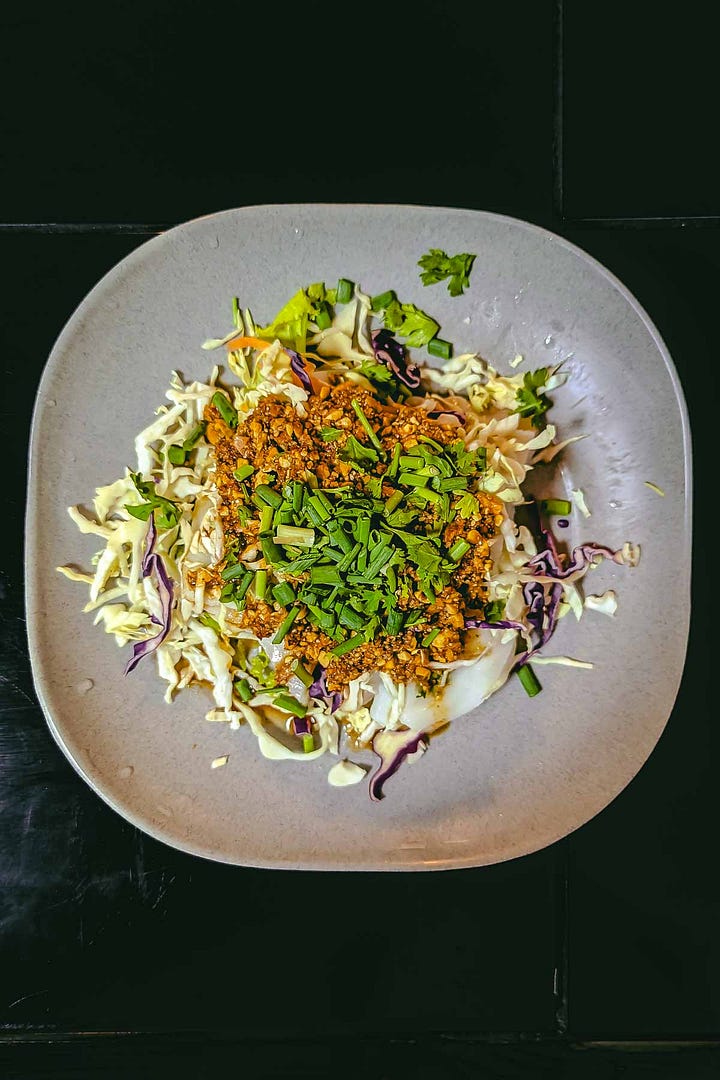
I’ve also seen this type of khao soi noi used as a parcel for Burmese fermented tea leaf salad. This is called khao soi noi hor yum bai cha (ข้าวซอยน้อยห่อยำใบชา), from Payod Shan Food in Chiang Mai, where the word hor refers to wrapping and yum bai cha is tea leaf salad.
Khao soi noi song kruang ข้าวซอยน้อยทรงเครื่อง
You may also see this referred to as khao soi loy nam, where the words loy nam mean to float on water. Both this and the aforementioned styles of khao soi noi are usually steamed by floating the tray directly on boiling water rather that in a steaming apparatus.
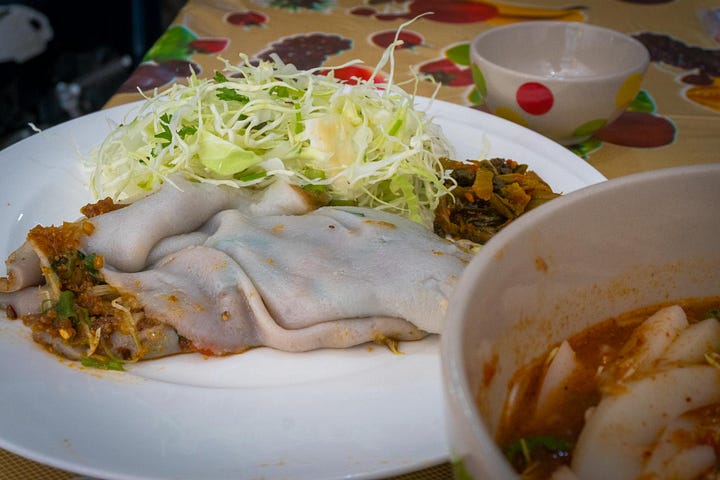
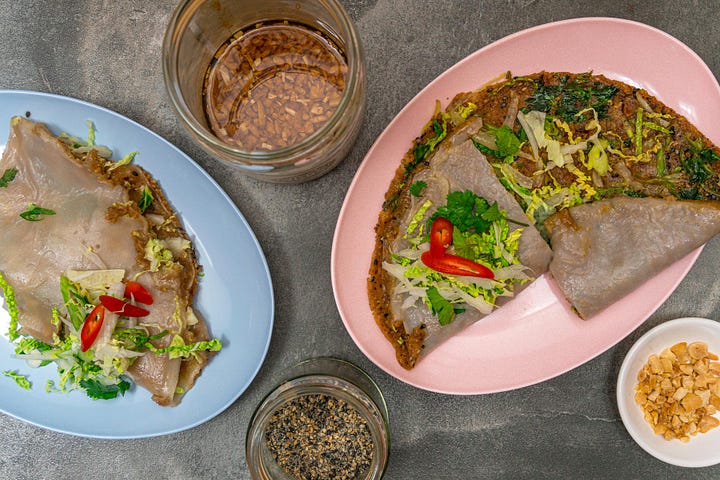
The process of making this begins by steaming a layer of rice batter until it solidifies. Then comes the fun part: choosing your seasonings. Typical options include chilli pastes, fried garlic oil, lime juice, MSG, ground toasted peanut and/or sesame, a local variety of dark soy sauce, toasted chilli powder, and more. For me the most important is tua nao moe ถั่วเน่าเม๊อะ, a blend of pounded chilli, fresh tua nao (effectively natto), ginger, and salt. The vendor will swirl these with some of the rice batter for the initial layer, toss some shredded veg on top, and steam it again.
You’ll sometimes find this particular type of khao soi noi referred to as Shan pizza, but I prefer sticking with something more accurate, like seasoned rice (noodle) pancake.
Khao soi luang ko ข้าวซอยเหลืองโก้
Ko is a Shan-Thai (Tai Yai) style salad, though a clear-cut definition of what qualifies as ko has been hard for me to pin down. Some sources claim it must include powdered tua nao, that fermented soy product widely used in Northern Thai and Burmese cuisine, yet I’ve consumed ko prepared by Tai Yai cooks without this ingredient. Other references suggest that a blended chili paste is essential, but in my experience observing and helping Tai Yai friends make ko at home, this is sometimes omitted.
I suspect the word ko often functions similarly to the term yum/yam in Thai, referring loosely to a salad, where ‘salad’ simply means mixing some ingredients with a dressing.
Case in point: the Shan yellow noodles salad below, or khao soi luang ko, made with turmeric, tomatoes, shredded cabbage, sesame, peanut, fried garlic oil, red onion, and herbs.
Here, the word luang refers to the colour yellow, indicating the type of noodles used in the salad.
Khao soi ko ข้าวซอยโก้
I purchased this bowl from a vendor with an entirely vegan stall in the town of Mae Hong Son. The noodles here are a fatter white variety, more akin to spaghetti. The seasoning is a little sweet, with ingredients including tomato, turmeric, crunchy bits of fried Burmese tofu, a little chilli, garlic oil, sesame seeds, some big chunks of coriander stem.
Sometimes the expansion of a category by adding more examples of what its components and terms are and aren't can give an impression of impaired clarity. This is the case with any subject we dive into, where the more information we take in the more we realise how much we still don't know. We should embrace this process and allow it to challenge our egos, prompting us to ask more questions and never assume we have all the answers. If we view thinking as reaching a final, unwaverable conclusion, we are truly limiting ourselves.
In other words, khao soi is as diverse as the people who make and name them. I’ll never encounter every variety, in the same way that I’ll never taste every kind of red sauce, and that’s fine. Actually it’s better than fine because it means there’s always more to learn.





